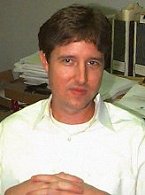Parallel Profile - Clint N. Dawson
Associate Professor, Department of Aerospace Engineering and Engineering Mechanics, University of Texas at Austin
 Clint N. Dawson's research interests are in the areas of numerical analysis and parallel computing. He is particularly interested in finite element and finite difference methods applied to systems of nonlinear partial differential equations arising in subsurface and surface flow and transport. "I was always intrigued with the use of computers to solve differential equations, and fortunately, that's what I do for a living!" he says.
Clint N. Dawson's research interests are in the areas of numerical analysis and parallel computing. He is particularly interested in finite element and finite difference methods applied to systems of nonlinear partial differential equations arising in subsurface and surface flow and transport. "I was always intrigued with the use of computers to solve differential equations, and fortunately, that's what I do for a living!" he says.
Dawson received his B.A. and M.S. degrees in mathematics from Texas Tech University in 1982 and 1984. "My M.S. thesis advisors, Ron Anderson and Wayne Ford, told me I should go on to get a Ph.D., which was the furthest thing from my mind at the time," he says. "Ford arranged for me to meet Mary Wheeler, then a professor of Computational and Applied Mathematics (CAAM) at Rice University, and she obtained a scholarship for me to come to Rice as a graduate student. She helped me a great deal when I was a graduate student and throughout my career."
After receiving his Ph.D. in mathematical science from Rice in 1988, Dawson was a National Science Foundation Postdoctoral Fellow and Dickson Instructor in the Department of Mathematics at the University of Chicago. In 1990, he was recruited back to Rice as an assistant professor of CAAM and was promoted to associate professor in 1994. In 1995, he moved to the University of Texas (UT) with Wheeler as part of her team of 13 interdisciplinary researchers that included two associate professors, three research scientists, three postdoctoral researchers, and four Ph.D. students.
Dawson is currently an associate professor in the Department of Aerospace Engineering and Engineering Mechanics at UT and is a member of the Texas Institute for Computational and Applied Mathematics (TICAM) and its subsidiary, the Center for Subsurface Modeling (CSM). The CSM investigates the use of high-performance parallel processing as a tool to simulate the behavior of petroleum reservoirs and groundwater aquifers. Dawson was a consultant for Shell Development Company from 1990-1997.
"My major contributions have been in the areas of modeling of flow in porous media and surface water, in parallel computation, and in the general area of numerical solutions to partial differential equations," Dawson says. "I am proud to be one of the founding members and part of UT's CSM. I think we have brought together a great group of students, post-docs, and faculty working to solve some very interesting problems, and are building interactions with industry, government laboratories, and state agencies."
Dawson has been a member of the CRPC since its inception in 1989. "The CRPC is an excellent forum for the exchange of ideas," he says. "It has been very helpful to me personally, providing support for my research, access to high-performance computing facilities, and unique educational programs, such as Spend a Summer with a Scientist (SaS). I was an SaS participant for three summers while I was at Rice." (See "Summer Research Program at Rice Hits Ninth Year.")
Dawson has authored or co-authored more than 50 technical articles. He was elected program chairman of the Society for Industrial and Applied Mathematics (SIAM) Activity Group on Geosciences in 1995 and was the organizing chair of the Fourth SIAM Conference on Mathematical and Computational Issues in 1997. He is also the organizing chair for the fifth meeting, which will be held in San Antontio in March 1999. He serves on the editorial boards of the Journal of Computational Geosciences and Advances in Water Resources.
Table of Contents
 Clint N. Dawson's research interests are in the areas of numerical analysis and parallel computing. He is particularly interested in finite element and finite difference methods applied to systems of nonlinear partial differential equations arising in subsurface and surface flow and transport. "I was always intrigued with the use of computers to solve differential equations, and fortunately, that's what I do for a living!" he says.
Clint N. Dawson's research interests are in the areas of numerical analysis and parallel computing. He is particularly interested in finite element and finite difference methods applied to systems of nonlinear partial differential equations arising in subsurface and surface flow and transport. "I was always intrigued with the use of computers to solve differential equations, and fortunately, that's what I do for a living!" he says.